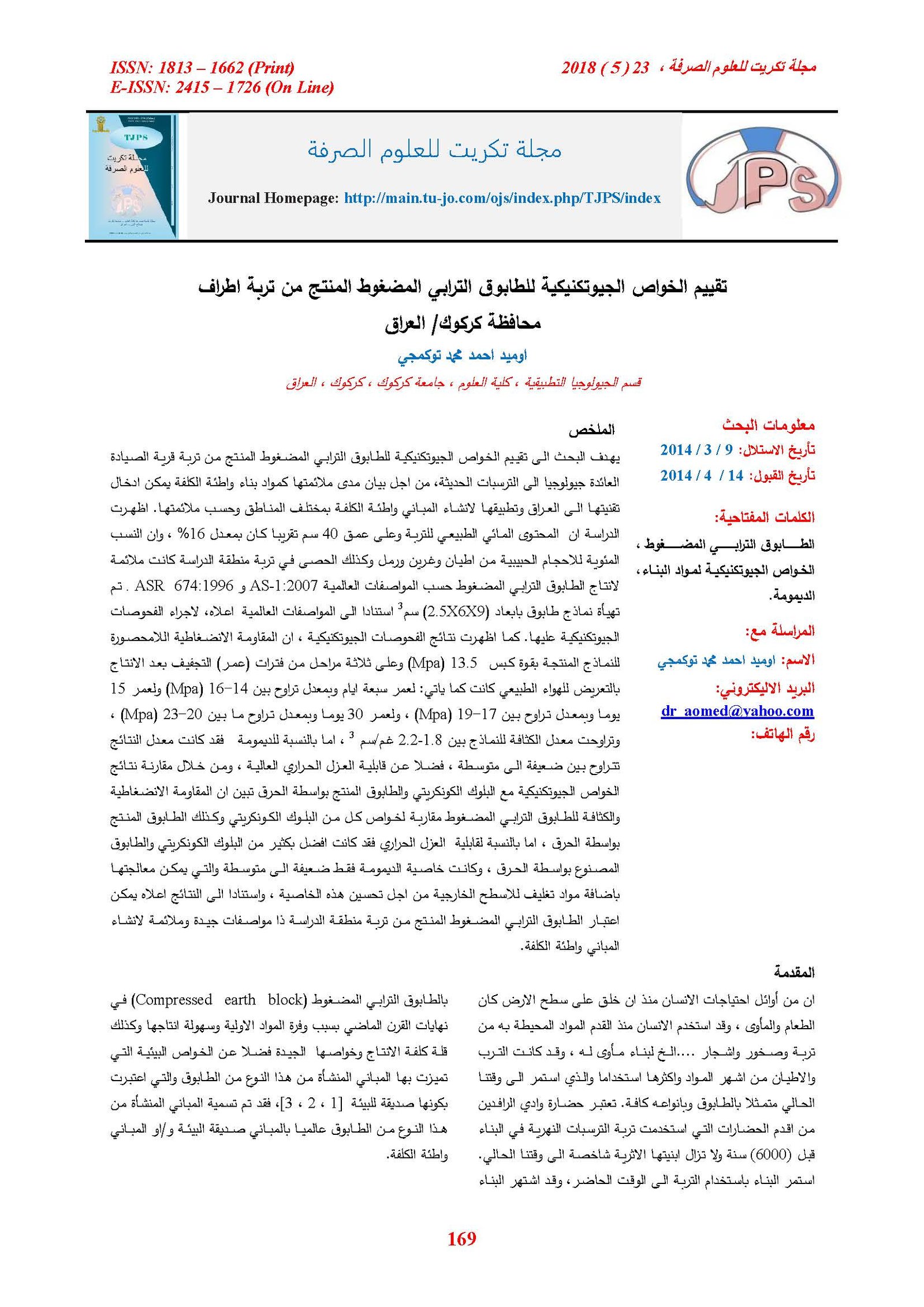Evaluation of geotechnical properties for compressed earth blocks produced from the parties of Kirkuk governorate/ Iraq
Main Article Content
Abstract
In this research the soil (Quaternary Sediments) from Al-Sayada village, South of Kirkuk Governorate, are selected to produce compressed earth block, the study aimed to evaluate the geotechnical properties of compressed earth blocks, in order to establish suitable low cost building technology, which may introduced to various parts of Iraq. The range natural moisture content of the soil in depth (40) cm was )16 %), where as the grain size from clay, silt, sand & gravel of the area soil was favorable to produce compressed earth blocks according to international standards AS-1:2007 & ASR 674:1996. Block samples (9X6X2.5) cm3 were prepared for geotechnical testes. The geotechnical tests results were revealed, that the unconfined compressive strength of the blocks, being produced under the compression (13.5 MPA), after three periods of drying under natural air as follows: age of (7) days rate (14-16) Mpa, age of (15) days rate (17-19) Mpa & age of (30) days rate (20-23)Mpa, The rate of density was between (2.2 -1.8) gm/cm3, while for durability the rate was ranging from weak to medium, in addition to the applicability of very high thermal insulation. It has been concluded by comparison the results of the geotechnical properties of compressed earth blocks, with concrete block & fired bricks properties, that the compressive strength & density specificities was relatively favorable with each other. The ability of thermal insulation, was found to be better than concrete block & fired bricks, so it can be considered, that the soil of studying area is suitable for producing compressed earth blocks, with good specifications and cost low-lying buildings. The weakness property to the durability was to recommended for further studies to find alternatives for packaging interfaces in order to support durability property.
Article Details

This work is licensed under a Creative Commons Attribution 4.0 International License.
Tikrit Journal of Pure Science is licensed under the Creative Commons Attribution 4.0 International License, which allows users to copy, create extracts, abstracts, and new works from the article, alter and revise the article, and make commercial use of the article (including reuse and/or resale of the article by commercial entities), provided the user gives appropriate credit (with a link to the formal publication through the relevant DOI), provides a link to the license, indicates if changes were made, and the licensor is not represented as endorsing the use made of the work. The authors hold the copyright for their published work on the Tikrit J. Pure Sci. website, while Tikrit J. Pure Sci. is responsible for appreciate citation of their work, which is released under CC-BY-4.0, enabling the unrestricted use, distribution, and reproduction of an article in any medium, provided that the original work is properly cited.
References
[1] E. A. Adam, Compressed Stabilized Earth Block Manufacturing in Sudan, Geopho print for the United nations educational, scientific & cultural organization, France UNECO, 2001, 114 p.
[2] Anon, Introduction to The Production of Compressed Stabilized Earth Block (CSEB) using any way soil block, Auroville earth institute, ,2007, 35 p.
[3] J. Arumala & T. Gondal, Compressed Earth Building Blocks for Affordable Housing, RICS, United Kingdom, 2007, 176 p.
[4] H. Houben & et. al., Compressed Earth Blocks Standards Guide, series technologies, Belgium, 1998, 142 p.
[5] K. Kabiraj & U. K. Maundal, Experimental Investigations and Feasibility Study on Compacted Earth Block Using Local Resources, International Journal of Civil & Structural Engineering, Vol.2, 2012, pp. 838-850.
[6] J. Kozel, A Text on Density and Porosity of Rocks, UK, 1975, 33p.
[7] S. Lenci & et. al., An Experimental Study on Damage Evaluation of Un Fired Dry Earth Under Compression, International Journal of fracture, Springer, Vol. 18, 2011, pp. 213- 218.
[8] A. Guettala & et. al., Durability of Lime Stabilized Earth Blocks, Courrier Du SAVOIR, Algeria, 2002, pp. 61-66.
[9] Y. KH. Al- Sakkaf, Durability Properties of Stabilized Earth Blocks, Thesis of doctor, University of Malaysia, 2009, 260 p.
[10] R.B. Johanson & J. V. Degraf, Principles of Engineering Geology, John wiley & Sons Inc., USA, 1988, 497 p.
[11] ASTM, C177-97 Designation, "Standard Test Method for Steady-State Heat Flux Measurements & Thermal Transmission Properties By Means of The Guarded-hot Apparatus", ASTM international, 2003, 24p.
